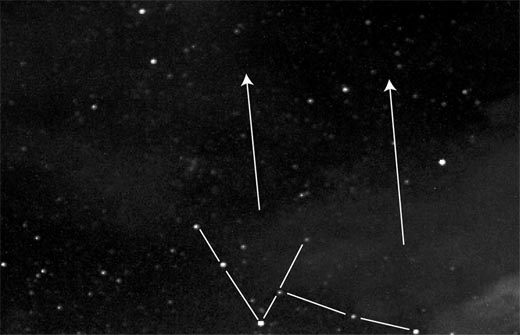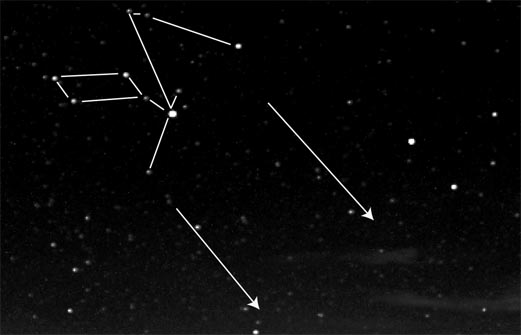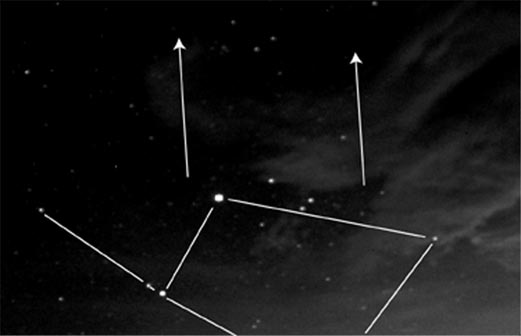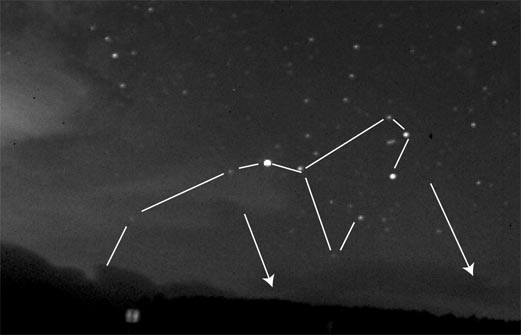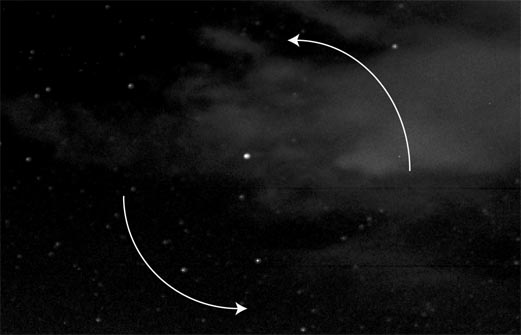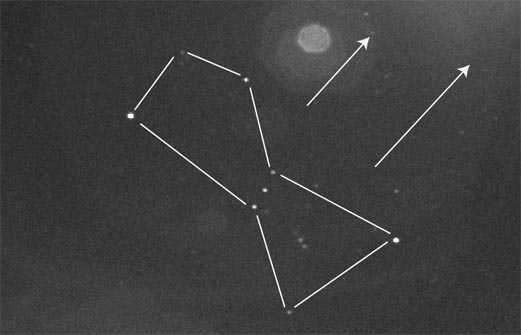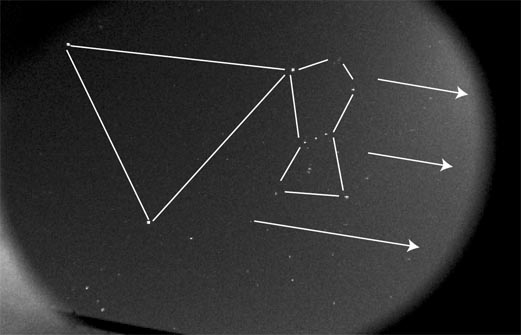HOME|Ideas and resoueces for planetary science experiments|Observing the Daily Motion of the Stars
宇宙の実験教室
Ideas and resoueces for planetary science experiments
カテゴリ
Category
- 実験教室Idea and Resources for Space science experiments
- 対象項目別Category: Contents
- 学年単元別Category: Study Age
-
- 実践授業Activity Reports
タグ
Tag
 星の日周運動の映像を見よう
星の日周運動の映像を見よう
ねらい
星の日周運動を理解しよう。
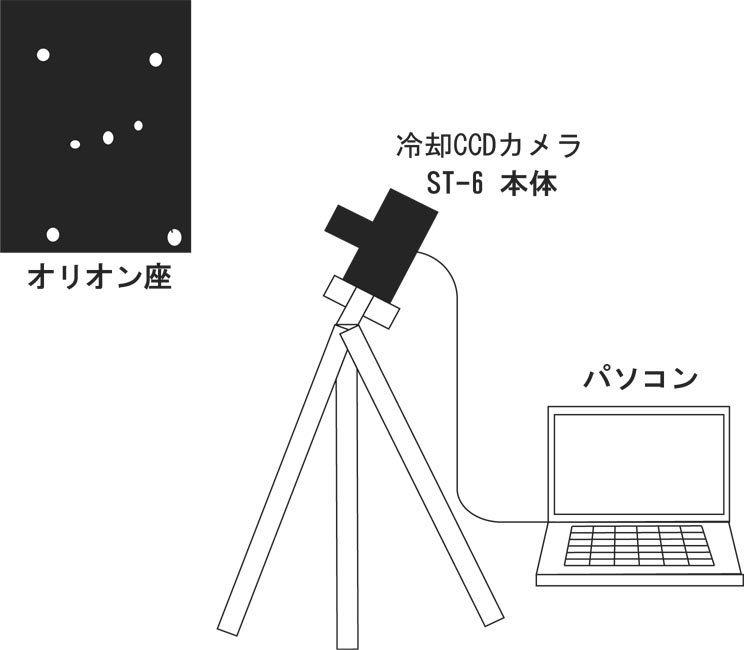 夜空に輝く美しい星たち。夏には七夕のお話で有名なアルタイル(牽牛星)のあること座、ベガ(織姫星)のあるわし座、 冬の散歩道で空を見上げて,真っ先に目に飛び込んでくるのはオリオン座でしょうか。
夜空に輝く美しい星たち。夏には七夕のお話で有名なアルタイル(牽牛星)のあること座、ベガ(織姫星)のあるわし座、 冬の散歩道で空を見上げて,真っ先に目に飛び込んでくるのはオリオン座でしょうか。
これらの星座、星たちは季節によって移り変わっているようですが、時間によってはどうでしょう?
同じ日の夜の7時と夜中の12時では星座の位置は違っているのでしょうか? 一日の間に星は動いているのでしょうか?
この教材は、星の日周運動を観察するために、広視野の星空の様子を高感度冷却CCDカメラで連続して撮像し,それらをつなげて映像としたものです。
さそり座・オリオン座・冬の大三角形などの代表的な星座が、星座の形を変えずに、 日本では向かって左から右に運動していき、 北極星周辺では反時計回りに運動している様子を見ることができます。
教科書に載っている長時間露出の星空写真では、どちらに向かって動いているのかがわかりませんが、 高感度CCDカメラを用いたこの映像は運動の方向も容易に確認でき、実際の星空の雲の動きなども入って 現実感のある映像となっています。
日周運動ムービー集
日周運動ムービー
冷却CCDカメラ STー6 および 16mm魚眼望遠レンズを使用して撮影 (撮影者 吉田和剛)
2002年8月6日 宮城蔵王山腹にて
ペルセウス座(冷却温度 0℃ 露出時間 4秒 で撮影)
東の空から昇っている様子を撮影しました. |
こと座(ベガ)(冷却温度 0℃ 露出時間 10秒 で撮影)
画面の中央左上に見える明るい星が,仙台では有名なベガです. 沈んでいくところを撮影したため,画面の下方向が地平線になっています. |
ぎょしゃ座(カペラ)(冷却温度 0℃ 露出時間 10秒 で撮影)
画面下方向が東の地平線で,上方向が天頂です. |
さそり座(アンタレス)(冷却温度 5℃ 露出時間 4秒 で撮影)
夏の代表的な星座である,さそり座が西に沈む様子を撮影しました. |
北極星周辺(冷却温度 5℃ 露出時間 4秒 で撮影)
画面中心に見える明るい星が北極星です. 2002年12月17日 宮城教育大学屋上にて |
オリオン座(冷却温度 -30℃ 露出時間 3秒 で撮影)
冬の代表的な星座です. |
冬の大三角(冷却温度 -30℃ 露出時間 1秒 で撮影)
オリオン座と冬の大三角を同時に撮影しました. |
 Observing the Daily Motion of the Stars
Observing the Daily Motion of the Stars
Introduction
An Introduction to the Daily Motion of the Stars
 The night sky contains many beautiful bright stars. On summer nights we can see Altair and Vega, the hero and heroine of the famous Star Festival. Alternatively, while out for an evening walk in winter, the constellation of Orion will be the first thing to catch your eye. It seems that the appearance of the night sky changes with the seasons. Is there some connection with the time of day? Do the positions of the constellations change between 7pm and 12 midnight? Do the stars move over the course of the day? We observed the daily motion of the stars by taking a series of wide-field images of the night sky using a high-sensitivity cooled CCD camera. These images were then combined to make a movie. We imaged Winter Triangle and the constellations of Scorpius and Orion. We found that their shapes do not change with time, but from our observing site in Japan they moved from left to right across the sky. We also found that the stars circled anticlockwise around the pole star. Time exposure photographs of stars in textbooks do not tell us the direction that stars are moving in. However, the images we obtained using a high sensitivity cooled CCD camera let us determine the direction of movement easily. We can even track the movement of clouds against the starry background, and this adds a sense of realism to the image.
The night sky contains many beautiful bright stars. On summer nights we can see Altair and Vega, the hero and heroine of the famous Star Festival. Alternatively, while out for an evening walk in winter, the constellation of Orion will be the first thing to catch your eye. It seems that the appearance of the night sky changes with the seasons. Is there some connection with the time of day? Do the positions of the constellations change between 7pm and 12 midnight? Do the stars move over the course of the day? We observed the daily motion of the stars by taking a series of wide-field images of the night sky using a high-sensitivity cooled CCD camera. These images were then combined to make a movie. We imaged Winter Triangle and the constellations of Scorpius and Orion. We found that their shapes do not change with time, but from our observing site in Japan they moved from left to right across the sky. We also found that the stars circled anticlockwise around the pole star. Time exposure photographs of stars in textbooks do not tell us the direction that stars are moving in. However, the images we obtained using a high sensitivity cooled CCD camera let us determine the direction of movement easily. We can even track the movement of clouds against the starry background, and this adds a sense of realism to the image.
Movie of Diurnal Motion
The movies below were obtained using a cooled CCD ST-6 camera and a 16mm fisheye telephoto lens (Picture Credit: Kazutaka Yoshida).
2002 August 6, from the Zao mountains in Miyagi
Perseus (Cooling Temperature 0℃, 4 sec exposure)
We imaged the constellation climbing into the eastern sky. You will see that the way the constellation moves in one hour is well illustrated. |
Lyra (Vega) (Cooling temp 0℃, 10 sec exposure)
The bright star in the left centre of the image is Vega, well known in Sendai. Because the constellation was setting as the image was taken, the horizon is at the bottom. Polaris lies off the right hand edge of the image. |
Auriga (Capella) (Cooling temp 0℃, 10 sec exposure)
In the image the eastern horizon is towards the bottom of the picture, and the zenith is towards the top. The bright star in the centre of the image is Capella. It is rising in the eastern sky just before dawn. In the animated image, clouds obscure the constellation before the end. |
Scorpius (Antares) (Cooling temp 5℃, 4 sec exposure)
This is a principle summer constellation, and was imaged as it sank into the western sky. In the image, the western horizon is towards the bottom of the image, while the zenith is at the top. The conspicuous bright star at the centre of the image is Antares. The occasional bright flashes during the animated image are from the headlights of passing cars. |
Polaris region (Cooling temp 5℃, 4 sec exposure)
The bright star at the centre of the image is Polaris. It is not especially bright, but since no other bright stars are visible in this part of the sky, it is prominent. Looking carefully at the animated image, you will see that the stars rotate anticlockwise around Polaris, which remains in the centre of the image. 2002 Dec 17, from the roof of Miyagi University of Education |
Orion (Cooling tem -30℃, 3 sec exposure)
This is a principle winter constellation. In the image it has reached maximum altitude in the south. Sirius, the brightest star in the sky, is just off the lower edge of the image. The bright spots at the top of the image are reflections in the camera from moonlight. |
Winter Triangle (Cooling temp -30℃, 1 sec exposure)
Orion and the Winter Triangle were imaged at the same time. The Winter Triangle, comprised of the stars Betelgeuse, Procyon and Sirius, is clearly visible. A lot of cloud is present in the later stages of the animated image. |












